Abstract
Industrialization, anthropogenic activities, the exhaust of vehicles and exponential population growth have a significant impact on the outdoor air quality of megacities across the world. Karachi is one of the largest cities in Pakistan, South Asia. The dense population, rapid economic growth and unplanned industrial activities have improved the socioeconomic status but also deteriorated the air quality of Karachi. The severe increase in air pollution has become a threat to the local population in terms of their health issues, quality of life and environment. Therefore, it is essential to quantify and monitor the spatiotemporal variation in outdoor air quality parameters. The current study aims to monitor the air quality in four major industrial zones of Karachi for three years (2020–2022). The field data was collected during the periods of post-monsoon and pre-monsoon using the HAZ-SCANNER (HIM-6000) apparatus, which measured outdoor air pollutants such as carbon monoxide (CO), nitrogen oxides (NO2), sulfur dioxide (SO2) and particulate matter (PM10, PM2.5 and TSPM). The data from 24 stations was analyzed using statistical analysis tools to estimate the parameters and Arc GIS to map the spatial variation of each parameter. The result shows that the concentration of particulate matter (TSPM, PM2.5 and PM10), SO2, NO2 and CO values at sampling sites are moderate in the post-monsoon season as compared to the pre-monsoon season due to cyclical monsoon effects and exceed the environmental quality standards. It was also noted that the North Karachi industrial area is at lower risk due to the small-scale industry. The higher levels of air pollutants have numerous health implications and may cause chronic infections. The air pollutant has a severe impact on plant growth and soil. Therefore, it is important to implement local environmental standards regarding outdoor air pollutants to mitigate the adverse impact on human health and economic activities.
1. Introduction
The physical, chemical and biological agents that modify the natural composition are defined as air pollution [1]. It is one of the leading causes of death in the 21st century and poses a serious threat to human health [2]. WHO (2022) estimates that 99% of people worldwide breathe poor-quality air, and low-income countries are more vulnerable and live at high risk [1]. Worldwide, air pollution has caused more than 6.5 million deaths. Particularly low-income countries account for 90% of fatalities due to air pollution [3]. It also cost the globe 8.11 trillion USD in 2019, or 6% of the world’s GDP [4].
Recently, Asian countries have seen significant growth in terms of development, urbanization and energy use [5,6]. The number of sources of air pollution has considerably increased [7]. Air pollution has a significant impact on the food chain, ecosystem, climatic changes, metrology and human health [8]. In many Asian cities, such as Beijing, New Delhi and Karachi, this has resulted in poor air quality and high levels of air pollution with detrimental effects on people’s health and well-being [9]. Air pollution is responsible for millions of premature births and deaths each year and is a significant economic burden due to healthcare costs and the lost productivity of resources [10].
Air quality has a direct influence on climate change, and preemptive actions are needed from authorities to decrease the harmful effects on people and the environment. The goal of this study was to measure the level of atmospheric trace gases such as nitrogen oxides (NO2), carbon monoxide (CO), sulfur dioxide (SO2) and particulate matter (TSPM, PM10 and PM2.5) in four major industrial districts of Karachi City. The measured levels were then statistically analyzed for pre-monsoon and post-monsoon and compared to the recommended levels adopted by the Sind Environmental Protection Agency, Pakistan (SEPA). Karachi is one of the worst cities to have polluted air quality in the last two decades [11]. The climate, hot and dry weather, population, lifestyle, and anthropogenic activities also make this problem vulnerable [12]. It is also very unfortunate that no monitoring or study has been conducted to quantify the impact of industrial activities. It is imperative to examine the air quality consistently to evaluate the severity and efficiency of mitigation measures. This study focuses on the spatial-temporal analysis (2020–2022) and monitors the industrial zones’ air quality parameters: SO2, CO, NO2 and PM (PM2.5 and PM10). The current research also provides baseline data to compare the trend of industrial emissions with future research.
The economy of Karachi is larger and more diversified [13]. Numerous organizations in four industrial zones of the city, including Sindh Industrial and Trading Estate (SITE), Korangi Industrial and Trade Estate, North Karachi Industrial and Trade Estate, Port Qasim, FB Area, etc., have their industrial hubs in the city [14]. The un-planned and un-controlled expansion of industries and their increasing emissions is a main contributor to air contamination in both urban and rural areas [15,16,17]. Industries emit various pollutants such as particulate matter (PM), nitrogen oxides (NO2), sulfur dioxide (SO2) and volatile organic compounds, which can have detrimental effects on both the environment and public health [18].
Pollutants can travel long distances and affect areas far away from industrial zones, leading to the degradation of the environment and pollution of rural areas [19,20]. Air pollution exposure directly impacts the growth of plants and increases the risk of diseases in humans, e.g., Parkinson’s, type 2 diabetes, chronic pulmonary infection and respiratory problems [21,22]. It is important for industries to adopt green technologies and practices to reduce their emissions and minimize their impact on the environment. However, burning solid waste, municipal waste and construction waste poses a serious threat to both the environment and people [23]. Additionally, human health and ecosystem pollution also impact the economy, reduce agricultural productivity and increase healthcare costs [24]. Therefore, controlling air pollution is vital for sustainable development and to mitigate the negative impacts on the environment, human health and economy. Implementing regulations and policies to reduce air pollution from industries, vehicles and power plants, as well as promoting the use of renewable energy sources, can help address this critical issue. Numerous researchers and scientists have worked on several air quality models for air quality plotting and evaluating the health impacts [9,25,26]. Air pollution and its influence on plants, humans and water in Pakistan have been reviewed by many researchers in mega-cities of Pakistan [27,28,29,30]. Extreme employment movements enormous population growth and an exceptional rise in vehicle usage pose environmental influences in big cities [31,32]. As a result, air pollution throughout Asia, particularly in South Asia, where emission controller tools and approaches are not consistently being adopted, has posed a significant risk to the health, environment and quality of life [33]. Hence, reducing air pollution levels and improving air quality are prerequisites for sustainable development and the safety of present and future generations [34,35].
2. Materials and Methods
2.1. Study Area
Pakistan is one of the largest countries (207.8 million population) in South Asia and Karachi is located in the south of Pakistan along the Arabian coastal belt of Sindh Figure 1. The world’s 3rd highly populated city (20 million) is known as the industrial and economic center of the country [36]. It covers a large extent of approximately 3530 km2 between latitude 24°43′–25°38′ N and longitude 66°43′–67°33′ E. The city altitude is 8 m, the annual precipitation is 250 mm, the summer season is from March–October, with a mean temperature of (25–35 °C), the winter season is November–February, with a mean temperature of (18–20 °C) and the velocity of wind (southwestern) exceeds 19.0 km/h. The wind direction in Karachi is predominantly from the southwest, except for 1.5 months (November and January) that experience wind from the north. During the period of monsoons (up to 70% humidity) from June–September [37].
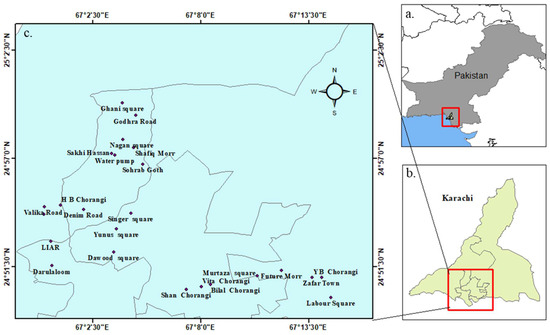
Figure 1.
Location map for the outdoor air quality monitoring site. (a) Pakistan, (b) Karachi and (c) twenty-four air monitoring stations in four major industrial zones of Karachi.
The city is divided into districts named District East, District Central, District South, District West, District Malir and District Korangi. There are four major industrial zones in Karachi, i.e., Landhi, Korangi, North Karachi and Sindh Industrial and Trading Estate (S.I.T.E.), which were selected to acquire the outdoor air quality sample. Table 1 shows the extent of industrial zones, types of industries and operations contributing to air pollution in Karachi.

Table 1.
The major industrial zones in Karachi SITE, Korangi, Landi and North Karachi.
2.2. Instrumentation
The data collection for 24 stations in four major industrial zones of Karachi was carried out using the Haz-Scanner (HIM) 6000. The air quality monitoring system (AQMS) is portable and able to measure the air quality parameters at trace levels, i.e., SO2, CO and NO2. The extensible apparatus measures PM (PM2.5 and PM10) simultaneously. Particle readings were taken using the infrared light scattering technique, while toxic gas readings were taken using electrochemical sensors.
During field measurement, the portable sensor often results in a linear error when compared with the standard equipment. The equipment calibration was carried out in the lab before conducting the sampling at selected stations. The range of equipment, accuracy and resolution for measuring parameters is provided in Table 2.

Table 2.
The field equipment range, accuracy and resolution to measure the outdoor air quality parameter and particulate matter.
2.3. Field Experiment and Sampling Procedure
The seasonal variation of air pollutants is studied by the researcher for megacities around the world [38,39,40]. The pre-monsoon and post-monsoon data were collected for three years to analyze the outdoor air quality of the study area. Each station was repeated every year during the pre-monsoon and post-monsoon. The total number of samples collected from 24 stations was 144. Each station was repeated two times for the years 2020, 2021 and 2022, including the COVID period. The industry in Karachi was fully operational during the COVID lockdown and continued to deteriorate the air quality. The average value for pre-monsoon and post-monsoon for three years (2020–2022) is summarized in Table 3.

Table 3.
Data of CO, NO2, SO2, TSPM, PM10 and PM2.5 for the average of 03 years 2020–2022 industrial sites in Karachi (µg/m3). PMS—pre-monsoon, PtMS—post-monsoon; SEQs—Sindh Environmental Quality Standards.
Textile operations, chemical products, glass, pharmaceuticals, plastic and food items are the main industries in these regions. SO2, NO2, CO, TSPM, PM10 and PM2.5 were among the pollutants analyzed. The data was gathered within the industrial boundaries during the busiest working shift (08:00–18:00) to cover the contribution of industrial emissions. The Haz-Scanner™ provides direct readings in real-time with data logging capabilities. Haz-Scanner is configured to provide log data at intervals of 20 min for eight hours for each station powered by a battery. It is a portable and deployable outdoor air quality monitor designed to measure and document critical hazardous air parameters. The equipment has a precision of +/− 0.003 mg/m³ (3µg/m³). The samples were acquired from localities in the months leading up to (May–June) for the pre-monsoon and (October–November) for the post-monsoon seasons. The collected data was analyzed and mapped using ARC GIS. The graphical presentation of field data collection to monitor industrial emissions is shown in Figure 2.
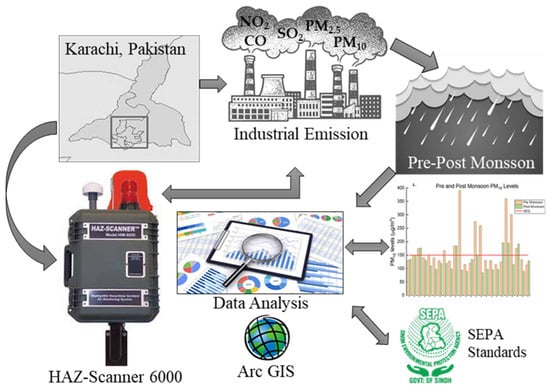
Figure 2.
Illustration of industrial emission monitoring and outdoor air quality parameter assessment of Karachi, Pakistan.
2.4. Statistical Analysis
Data for three years was analyzed using statistical analysis. The average of three-year data was calculated for the pre-monsoon and post-monsoon seasons. The data was run through regression analysis to analyze the relationship between dependent and independent variables. Overall, regression analysis is an effective tool for understanding relationships, making predictions and informing the decision-making processes. The correlation coefficient and coefficient of determination were also used to validate the statistical measure of how well the regression line approximates the data points. The structural equation model was formulated using statistical software by plotting the scattered diagram for each parameter, i.e., SO2, NO2, CO, TSPM, PM10 and PM2.5. The pre- and post-monsoon data for the acquired parameters were plotted on the x-axis and y-axis. The best-fitted line and the regression equations were generated on scattered diagrams. Finally, the measured values of air quality parameters were plotted on ARC GIS to evaluate the spatial distribution of outdoor air quality over the study area. The flow chart summarizes the methodology utilized for this research, as shown in Figure 3.
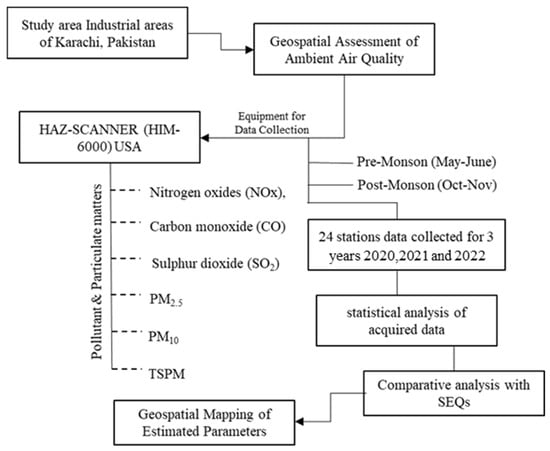
Figure 3.
Research methodology workflow for air quality analysis impact by industrial emissions.
3. Results and Discussion
One of the primary causes of the decline in outdoor air quality is pollution from industrial activity and violations of standards. The magnitude of industrial air pollution has increased significantly from the previous year [41]. In this research, an assessment was conducted to determine whether outdoor air data meets the Sindh Environmental Quality Standards (SEQS) or not. For this purpose, evaluation has been performed on a temporal and seasonal basis (Table 3). In the pre-monsoon, all four industrial regions, including Godhra Road, Sohrab Goth, Yunus Chorangi, Labour Square, Denim Road, Murtaza Chorangi, and Bilal Chorangi, had significantly high mean particulate matter values (TSPM, PM10 and PM2.5), whereas these locations had moderate amounts of NO2, CO and SO2. Figure 3 illustrates the changes in pre- and post-monsoon readings of various air pollutants, namely CO, NO2, SO2, TSPM, PM10 and PM2.5.
Figure 4 displays the pollutant levels along with a horizontal line representing the boundary set by the Sindh Environmental Quality Standards (SEQS). The difference between the two lines indicates a variation in pollutant concentration. Figure 4a shows the variation in CO readings; Figure 4b indicates the narrowing gap in NO2 levels in certain localities; and Figure 4c demonstrates that the difference between pre- and post-monsoon SO2 readings falls within acceptable limits. Figure 4d depicts areas of concern through the intersection of the SEQS boundary and noted readings for TSPM. The severity and presence of PM10 are shown in Figure 4e by the intersection of both lines, and Figure 4f highlights industry violations in PM2.5 levels at the intersection of the SEQS boundary and the observed readings during field data collection in the study area.
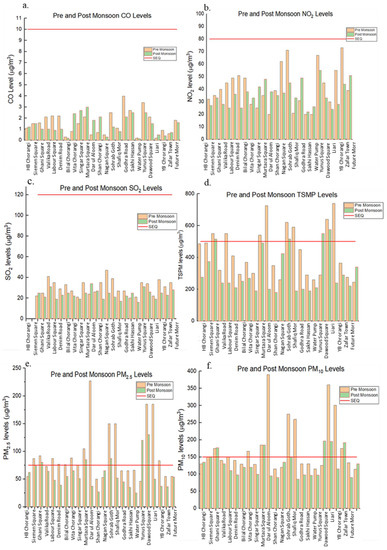
Figure 4.
Variation in air quality (pre-monsoon and post-monsoon) for monitored parameters at 24 stations in Karachi industrial areas: (a) CO, (b) NO2, (c) SO2, (d) TSPM, (e) PM2.5, and (f) PM10.
It is observed that the PM10 value in pre-monsoon in Habib Chorangi of SITE industrial area is 130 µg/m3 < 150 µg/m3 (SEQS). The main reason is the presence of heavy industry. Similarly, Siemen Chorangi, Ghani Chorangi, Valika Road and Labour Square are areas in the SITE industrial zone showing higher values for PM10 and PM2.5. In the Korangi industrial zone, Bilal Chorangi has PM10 187 > 150 µg/m3 (SEQS). Singer Chorangi has PM10, 201 µg/m3 > 150 µg/m3 (SEQs) and Murtaza Chorangi has PM10, 409 µg/m3 > 150 µg/m3 (SEQs). Similarly, Bilal Chorangi has PM2.5 97 µg/m3 >75 µg/m3 (SEQS), Singer Chorangi has PM2.5 117 µg/m3 > 75 µg/m3 (SEQS), Vita Chorangi has PM10, 81 µg/m3 > 75 µg/m3 (SEQS) and Murtaza Chorangi has PM2.5 238 µg/m3 > 75 µg/m3 (SEQS). This shows that Vita and Murtaza Chorangi are the worst cases in the presence of PM2.5.
In the pre-monsoon, North Karachi is a comparatively less polluted area, with only two exceeding values in Nagan Chorangi PM10 292 µg/m3 >150 µg/m3 (SEQS) and Sohrab Goth PM10 281 µg/m3 > 150 µg/m3 (SEQS). The value of PM2.5 is 173 µg/m3 > 75, and for Sohrab Goth, PM2.5 is 166 µg/m3 > 75 µg/m3 (SEQS). The value of TSPM is also on the higher side of these two areas. The Landhi industrial zones of Yunus and Dawood Chorangi have higher values of PM10 and PM2.5. Yunus Chorangi PM10 value is 371 µg/m3 > 150 µg/m3 (SEQS) and Dawood Chorangi PM10 329 µg/m3 >150 µg/m3 (SEQS). Similarly, values for PM2.5 for Yunus Chorangi are 198 µg/m3 > 75 µg/m3 (SEQS). The higher values of PM10 and PM2.5 indicate a higher risk for human health and living conditions.
It is also observed that the PM10 value in post-monsoon in Siemen Chorangi of SITE industrial area is 162 µg/m3 > 150 µg/m3 (SEQS), and PM10 for Ghani Chorangi is 187 µg/m3 > 150 µg/m3 (SEQS). The value of PM2.5 in Siemen Chorangi of SITE industrial area is 87 µg/m3 > 75 µg/m3 (SEQS), and PM2.5 for Ghani Chorangi is 85 µg/m3 > 75 (SEQS). The main reason is the presence of heavy industry using furnace oil, which directs emissions into the atmosphere. Similarly, Siemen Chorangi and Ghani Chorangi in the SITE industrial zone showed higher values for PM10 and PM2.5. The Korangi industrial zone of Murtaza Chorangi has a PM2.5 value of 92 > 75 µg/m3 and a TSPM value of 514 µg/m3 > 150 µg/m3 (SEQs). This shows that the Murtaza Chorangi location is facing the worst air quality and the presence of higher PM2.5 and TSPM.
In the post-monsoon period, North Karachi is a comparatively less polluted area, with only one exceeding of values in Sohrab Goth PM2.5 95 µg/m3 > 75 µg/m3 (SEQS). However, the value of TSPM is also on the higher side in Sohrab Goth. In the Landhi industrial zone, post-monsoon values show quite better results due to the effect of the monsoon, with no violation of SEQS. The better result can be attributed to the washing effect of rain.
Figure 5 depicts the correlation between pre- and post-monsoon values of various air pollutants in Karachi. Each sub-figure presents a specific pollutant’s correlation analysis along with the determination coefficient (R2), which indicates the extent to which the dependent variable (pre-monsoon values) can be explained by the independent variable (post-monsoon values). The R2 value for CO is 0.2753, indicating a weak correlation and suggesting that the values do not change significantly after the annual rains. Similarly, the correlation analysis for NO2 (R2 = 0.1551), SO2 (R2 = 0.0811), TSPM (R2 = 0.0402), PM10 (R2 = 0.0206) and PM2.5 (R2 = 0.0407) also exhibits weak correlations, suggesting limited changes in their values after the monsoon season. The provided structural equation models describe the relationships observed between the variables in each analysis, allowing for a better understanding of the patterns and trends in the data.
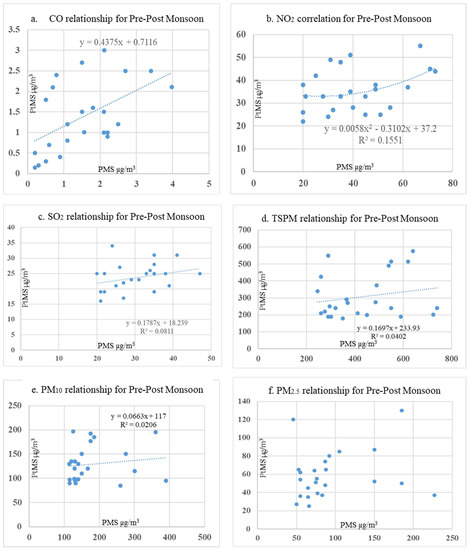
Figure 5.
Correlation analysis to evaluate the impact of monsoon season on air pollutant levels in Karachi for the collected sample measured in (µg/m3) during the pre-monsoon (PMS) on the x-axis and post-monsoon (PtMS) on the y-axis (a) CO, (b) NO2, (c) SO2, (d) TSPM, (e) PM2.5, and (f) PM10.
Table 4 encompasses parameters such as NO2, SO2, CO, TSPM, PM10 and PM2.5, each accompanied by a specific equation. These equations establish the relationship between the levels of pollutants, denoted as PTMS, and their corresponding independent variable, PMS. By providing coefficients and constants, these structural equation models quantify the associations between the variables.

Table 4.
Structural equation models for air pollutant parameters are utilized to estimate the correlation between pre-monsoon and post-monsoon.
Karachi industrial sites on GIS plotting depict the location, and no clear-cut demarcation of industrial and residential areas was found. The map shows (Figure 6 and Figure 7) that the southern and central regions are less affected comparatively. No clear-cut boundary demarcation shows that the effects are widespread and will affect the general populace in and attached to industrial areas.
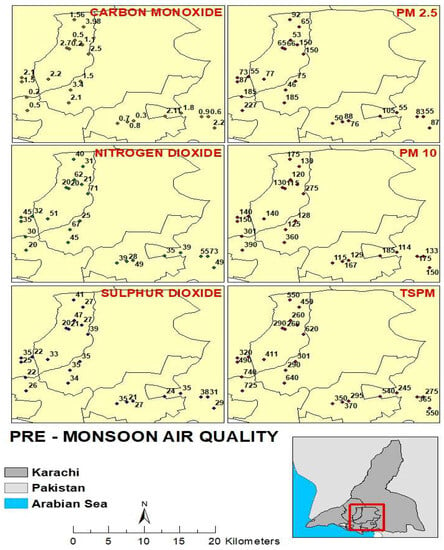
Figure 6.
Pre-monsoon geospatial analysis and visualization of air quality values for NO2, SO2, CO, TSPM, PM10 and PM2.5.
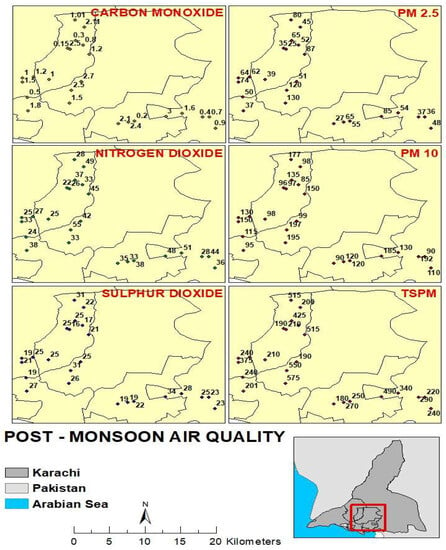
Figure 7.
Post-monsoon geospatial analysis and visualization using Arc GIS of air quality values for NO2, SO2, CO, TSPM, PM10 and PM2.5.
The 24 Karachi industrial sites’ air quality average data for three years (2020–2022) was plotted on Arc GIS to represent the spatial distribution of each parameter, i.e., NO2, SO2, CO, TSPM, PM10 and PM2.5. The map shows that there is no demarcation of industrial and residential zones. The south-west, north-east and central regions are less affected, as shown in Figure 6 and Figure 7, due to negligible industrial activity. The presence of SO2 and CO is within the permissible limit over the study area, whereas the concentration of NO2 is higher for post-monsoon and pre-monsoon and close to the permissible limit as per SEQS. During pre-monsoon, North Karachi was a comparatively less polluted area, except for two stations, Nagan Chorangi and Sohrab Goth. They show higher PM10, as shown in Figure 7. The value of PM2.5 is also higher in Sohrab Goth. Similarly, these areas show higher values of TSPM. During the post-monsoon. Figure 8 shows that the North Karachi zone represents low values except for Sohrab Goth. Higher TSPM, PM2.5, and PM10 show no positive impact on air pollution due to the monsoon. The decreasing trend for post-monsoon results may be due to the washing effect of rain.
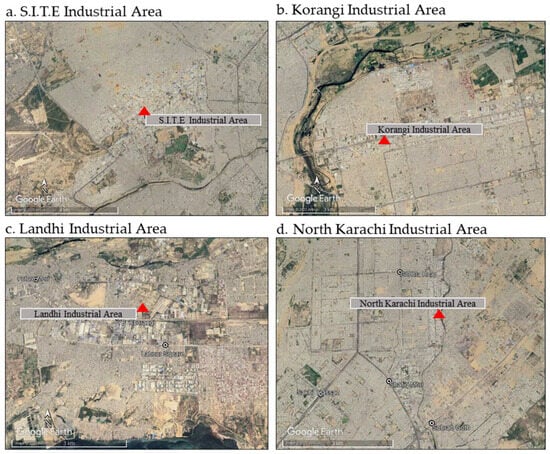
Figure 8.
Google Earth map shows that the Karachi industrial zones are surrounded by dense populations without any demarcation between industrial and residential areas (a) S.I.T.E industrial area, (b) Korangi industrial area, (c) Landhi industrial area, and (d) North Karachi industrial area.
In addition to natural processes, burning at very high temperatures produces NOx [42]. Nitrogen oxide is present in all industrial zones as a result of surrounding industries [43]. It is released into the atmosphere through power plants and automobile emissions at high levels. These nitrogen oxides have a crucial role in increasing photochemical pollution, including surface ozone (O3), in addition to their impact on human respiratory health [44]. The NOx in the atmosphere is to blame for common bronchitis and eye conditions in Karachi [27]. There are seven compounds of NOx, generated by anthropogenic (human) activities [45].
The Landhi industrial area, S.I.T.E. area, and Korangi are more likely to be exposed to these hazardous pollutants; the maximum concentration of the particulate matter PM10 and PM2.5 was also found in the air samples acquired from all locations. The values exceed the Sindh Environmental Protection Agency’s (SEPA) given standards of 150 and 75.0 µg/m3 for PM10 and PM2.5, respectively. Higher variations of PM10 and PM2.5 are caused by industrial and traffic-related factors in all zones. Open spaces in a nearby industrial activity that sees a lot of traffic for the transit of manufactured goods and raw materials especially contain higher levels of particulate matter (PM10 and PM2.5). During the sampling, it was also observed that the selected sites are surrounded by a dense population also living within the industrial zones of Karachi, as shown in Figure 8. The S.I.T.E. industrial area is very close to agricultural activities in the west and south within 2 km. The dense population is also exposed to industrial air pollution. Similarly, the Korangi industrial area is also close to the agricultural activities in the north and northwest along the river. Landhi and North Karachi are also surrounded by thickly populated areas within industrial zones, as shown in Figure 8.
Therefore, studies have shown that direct exposure to PM2.5 and PM10 is an important health factor for respiratory disease increase or worsening, as well as the increased possibility of different lung disorders [46]. PM2.5 and PM10 can go to extreme organs, resulting in multiple dysfunctions in a person [47]. The cardiovascular system is increasingly affected by air pollution [48]. The inflammatory state has been seen in many cases when exposed to PM2.5, and PM10. The changes in body systems can onset and/or worsen different pathological conditions. PM2.5 and PM10 are also linked to increased reactive oxygen species (ROS) formation and un-balanced antioxidant defense, leading to bimolecular injuries [49].
Besides the health impact, the PM also contaminates the soil [50,51], and there are three agriculture zones close to Korangi, S.I.T.E. and Landhi industrial areas. PM2.5 plays a vital role in carrying essential nutrients for plant growth [52]. Particulate matter is a complex element present in the soil environment, and it directly impacts the properties of the soil. The impact also depends on the source of PM origin, which modifies the physical, chemical and biological properties. The deposition of a particle on soil increases soil fertility; however, the higher PM2.5 results in excessive deposition that impacts the health of plants [53]. The trace elements from industrial emissions also imbalance the quality of the soil. The deposition of PM2.5 in the presence of moisture develops a crust on the soil surface, which affects infiltration. Moreover, it also contributes to altering and decreasing the microbial activity that provides organic matter through decomposition. The PM10 is larger than the PM2.5 and settles faster on the soil. These particles are not easy to wash and erode. The formation of crust affects porosity and negatively affects aeration and infiltration. The higher value of PM10 causes a negative impact and damages the plants, their leaves and their stems. In the study area, the main source of PM is fossil fuel burning in industrial zones of Karachi. It also increases the concentration of SO2 and NO2. Industries of cement, paper, chemicals and metals involved in combustion processes that emit PM and heavy metals are common in Landhi, SITE and Chorangi industrial areas. Therefore, these three are the major contributors to spoiling the soil of Karachi and have a severe impact on the ecosystem.
4. Conclusions
Air pollution concentrations have changed significantly in Pakistan in the last decade. The estimated results of this study show that the significant input of pollutants into outdoor air is provided by industrial activities in four districts in Karachi. The refineries, brickworks, cement factories, iron and steel smelters, quarries and fossil fuel power plants are the main sources of PM10, PM2.5, and TSMP in industrial areas of Karachi. Due to Karachi’s extensive industrial activities, poisonous gases and other pollutants can certainly accumulate in the outdoor air of the city, which has an adverse impact on its inhabitants and local environment. It is important to note that the severity of these health impacts can vary depending on factors such as the type and concentration of pollutants, duration of exposure, and individual susceptibility. The graphical and statistical modeling shows that the presence of SO2, NO2, CO and PM is present and persistent despite monsoon rain showers. Therefore, more concrete measures are needed to control their presence to avoid the degradation of air quality, the spread of diseases and environmental degradation. According to study results, the industrial areas of S.I.T.E., Landhi and Korangi are particularly directly exposed to polluting gases. The North Karachi industrial zone is spread over a large space, which is why this region is at the lowest risk except for Sohrab Goth. The responsible authorities failed to implement the law properly for un-planned industrial zones in Karachi.
This study concluded the particulate matter presence in Karachi industrial regions. The dense population lives within the industrial zones of Karachi. The PM10 and PM2.5 readings are often two to three times higher than the SEQS requirements. The values for PM10 and PM2.5 in both seasons, pre-monsoon and post-monsoon, are higher. Therefore, monsoons have no positive impact on the air quality in Karachi. The direction of wind in Karachi from the west does not change during the pre-monsoon and post-monsoon. The higher values in Landhi for PM are due to the industries using furnace oil and not following the SOPs. Studies conducted in other advanced nations have also shown a strong correlation between higher PM10 and PM2.5 and the hospitalization rates for hypertension and cardiovascular disorders (ischemic heart disease and myocardial infarction) [54]. Studies also depict that higher PM severely impacts soil and plant growth.
Metropolitan-developed cities across the globe, such as New Delhi, India, and cities in China, are facing the same dilemma [55,56]. Additional research on the health implications in the megacity of Karachi is imperative given the obvious levels of air pollution that are acknowledged. The strict emission standards and regulation implementation for industries in Karachi are required to protect the soil, water, and people’s health by reducing emissions and minimizing NO2, PM2.5, and PM10.
Author Contributions
Conceptualization, M.I. (Mohammad Idrees) and Y.N.; methodology, M.I. (Mohammad Idrees); software, Y.N.; validation, M.I. (Mohammad Idrees) and M.I. (Muhammad Irfan); formal analysis, M.I. (Muhammad Irfan); investigation, M.I. (Mohammad Idrees); resources, Y.N.; data curation, M.I. (Mohammad Idrees); writing—original draft preparation, (Muhammad Irfan); writing—review and editing, Y.N.; visualization, M.I. (Muhammad Irfan); supervision, Y.N.; project administration, M.I. (Mohammad Idrees) and Y.N.; funding acquisition, M.I. (Mohammad Idrees). All authors have read and agreed to the published version of the manuscript.
Funding
This research received no external funding.
Institutional Review Board Statement
Not applicable.
Informed Consent Statement
Not applicable.
Data Availability Statement
All data are provided in the manuscript.
Acknowledgments
M.I. extend his heartfelt gratitude to the Department of Earth and Environmental Sciences for providing technical expertise, lab support, and guidance. The authors also extend their appreciation to Bahria University Karachi Campus for granting essential resources and environment to conduct this research.
Conflicts of Interest
The authors declare no conflict of interest.
References
- WHO. World Health Organization Global Air Quality Guidelines: Particulate Matter (PM2.5 and PM10), Ozone, Nitrogen Dioxide, Sulfur Dioxide and Carbon Monoxide; World Health Organization: Geneva, Switzerland, 2022. [Google Scholar]
- Moyebi, O.D.; Sannoh, F.; Fatmi, Z.; Siddique, A.; Khan, K.; Zeb, J.; Hussain, M.M.; Carpenter, D.O.; Khwaja, H.A. State of gaseous air pollutants and resulting health effects in Karachi, Pakistan. Environ. Monit. Assess. 2023, 195, 266. [Google Scholar] [CrossRef]
- Fuller, R.; Landrigan, P.J.; Balakrishnan, K.; Bathan, G.; Bose-O’Reilly, S.; Brauer, M.; Caravanos, J.; Chiles, T.; Cohen, A.; Corra, L. Pollution and health: A progress update. Lancet Planet. Health 2022, 6, e535–e547. [Google Scholar] [CrossRef]
- Bank, W. The Global Health Cost of PM2.5 Air Pollution: A Case for Action beyond 2021; The World Bank: Washington, DC, USA, 2022. [Google Scholar]
- Moore, M.J.; Rathish, B.; Zahra, F. Monkeypox. In StatPearls; StatPearls Publishing: St. Petersburg, FL, USA, 2022. [Google Scholar]
- Zaman, H.M.; Saqib, Z.; Bokhari, A.S.; Akhtar, N.; Amir, S. The Dynamics of Urbanizations and Concomitant Land Use Land Cover Transformations in Planned and Quasi-Planned Urban Settlements of Pakistan. Geogr. Environ. Sustain. 2020, 13, 107–120. [Google Scholar] [CrossRef]
- Dahiya, B.; Das, A. New Urban Agenda in Asia-Pacific: Governance for Sustainable and Inclusive Cities; Springer: Berlin/Heidelberg, Germany, 2020. [Google Scholar]
- Agrawal, M.; Shashi, B. Effects of air pollution on plant diversity. In Environmental Pollution and Plant Responses; Routledge: Oxfordshire, UK, 2023; pp. 137–152. [Google Scholar]
- Chang, D.; Ding, Y.; Xie, J.; Bhunia, A.K.; Li, X.; Ma, Z.; Wu, M.; Guo, J.; Song, Y.-Z. The devil is in the channels: Mutual-channel loss for fine-grained image classification. IEEE Trans. Image Process. 2020, 29, 4683–4695. [Google Scholar] [CrossRef]
- Philip, R.K.; Purtill, H.; Reidy, E.; Daly, M.; Imcha, M.; McGrath, D.; O’Connell, N.H.; Dunne, C.P. Reduction in preterm births during the COVID-19 lockdown in Ireland: A natural experiment allowing analysis of data from the prior two decades. MedrXiv, 2020; preprint. [Google Scholar] [CrossRef]
- Tariq, M. Air Quality of Karachi and Lahore: How does the energy industry of Pakistan affect it? In Proceedings of the 2023 6th International Conference on Energy Conservation and Efficiency (ICECE), Lahore, Pakistan, 15–16 March 2023; pp. 1–4. [Google Scholar]
- Baqa, M.F.; Lu, L.; Chen, F.; Nawaz-ul-Huda, S.; Pan, L.; Tariq, A.; Qureshi, S.; Li, B.; Li, Q. Characterizing spatiotemporal variations in the urban thermal environment related to land cover changes in Karachi, Pakistan, from 2000 to 2020. Remote Sens. 2022, 14, 2164. [Google Scholar] [CrossRef]
- Seidah, N.G.; Awan, Z.; Chrétien, M.; Mbikay, M. PCSK9: A key modulator of cardiovascular health. Circ. Res. 2014, 114, 1022–1036. [Google Scholar] [CrossRef] [PubMed]
- Wang, W.; Wang, S.; Ma, X.; Gong, J. Recent advances in catalytic hydrogenation of carbon dioxide. Chem. Soc. Rev. 2011, 40, 3703–3727. [Google Scholar] [CrossRef]
- Lin, B.; Ouyang, X. Energy demand in China: Comparison of characteristics between the US and China in rapid urbanization stage. Energy Convers. Manag. 2014, 79, 128–139. [Google Scholar] [CrossRef]
- Urhie, E.; Afolabi, A.; Afolabi, A.; Matthew, O.; Osabohien, R.; Ewetan, O. Economic growth, air pollution and health outcomes in Nigeria: A moderated mediation model. Cogent Soc. Sci. 2020, 6, 1719570. [Google Scholar] [CrossRef]
- Khoshnevis Yazdi, S.; Khanalizadeh, B. Air pollution, economic growth and health care expenditure. Econ. Res.-Ekon. Istraživanja 2017, 30, 1181–1190. [Google Scholar] [CrossRef]
- Zheng, Y.; Goh, E.; Wen, J. The effects of misleading media reports about COVID-19 on Chinese tourists’ mental health: A perspective article. Anatolia 2020, 31, 337–340. [Google Scholar] [CrossRef]
- Svensson, J.-E.; Johansson, L.-G. A laboratory study of the initial stages of the atmospheric corrosion of zinc in the presence of NaCl; Influence of SO2 and NO2. Corros. Sci. 1993, 34, 721–740. [Google Scholar] [CrossRef]
- Merico, E.; Dinoi, A.; Contini, D. Development of an integrated modelling-measurement system for near-real-time estimates of harbour activity impact to atmospheric pollution in coastal cities. Transp. Res. Part D Transp. Environ. 2019, 73, 108–119. [Google Scholar] [CrossRef]
- Xu, H.; Jia, Y.; Sun, Z.; Su, J.; Liu, Q.S.; Zhou, Q.; Jiang, G. Environmental pollution, a hidden culprit for health issues. Eco-Environ. Health 2022, 1, 31–45. [Google Scholar] [CrossRef]
- Fattorini, D.; Regoli, F. Role of the chronic air pollution levels in the Covid-19 outbreak risk in Italy. Environ. Pollut. 2020, 264, 114732. [Google Scholar] [CrossRef] [PubMed]
- Premsudha, D.R.; Vasareddy, A.; Saiteja, B.; Sreeja, B.; Chandana, G. Impact Assessment on Air Quality around Integrated Municipal Solid Waste Management Plant in Hyderabad. Int. J. Adv. Res. Sci. Commun. Technol. 2022, 2, 666–677. [Google Scholar] [CrossRef]
- Zhang, B.-Z.; Chu, H.; Han, S.; Shuai, H.; Deng, J.; Hu, Y.-F.; Gong, H.-R.; Lee, A.C.-Y.; Zou, Z.; Yau, T. SARS-CoV-2 infects human neural progenitor cells and brain organoids. Cell Res. 2020, 30, 928–931. [Google Scholar] [CrossRef]
- Kumar, S.; Ahlawat, W.; Kumar, R.; Dilbaghi, N. Graphene, carbon nanotubes, zinc oxide and gold as elite nanomaterials for fabrication of biosensors for healthcare. Biosens. Bioelectron. 2015, 70, 498–503. [Google Scholar] [CrossRef] [PubMed]
- Westhoek, H.; Lesschen, J.P.; Rood, T.; Wagner, S.; De Marco, A.; Murphy-Bokern, D.; Leip, A.; van Grinsven, H.; Sutton, M.A.; Oenema, O. Food choices, health and environment: Effects of cutting Europe’s meat and dairy intake. Glob. Environ. Change 2014, 26, 196–205. [Google Scholar] [CrossRef]
- Zeeshan, H.M.A.; Lee, G.H.; Kim, H.-R.; Chae, H.-J. Endoplasmic reticulum stress and associated ROS. Int. J. Mol. Sci. 2016, 17, 327. [Google Scholar] [CrossRef]
- Khan, W.A.; Sharif, F.; Khokhar, M.F.; Shahzad, L.; Ehsan, N.; Jahanzaib, M. Monitoring of Ambient Air Quality Patterns and Assessment of Air Pollutants’ Correlation and Effects on Ambient Air Quality of Lahore, Pakistan. Atmosphere 2023, 14, 1257. [Google Scholar] [CrossRef]
- Milivojević, L.; Mrazovac Kurilić, S.; Božilović, Z.; Koprivica, S.; Krčadinac, O. Study of Particular Air Quality and Meteorological Parameters at a Construction Site. Atmosphere 2023, 14, 1267. [Google Scholar] [CrossRef]
- Rehmat, R.; Rafique, L.; Irfan, M.; Ahmed, S.R.; Lahori, A.H.; Muhammadi, A.; Taha, M.; Vambol, S.; Shulga, M. Space-borne Air Quality Monitoring of Nitrogen dioxide (NO2) over Karachi and Lahore using Remote Sensing Tools. Proc. Pak. Acad. Sci. B Life Environ. Sci. 2023, 60. [Google Scholar] [CrossRef]
- Gurjar, B.R.; Butler, T.; Lawrence, M.; Lelieveld, J. Evaluation of emissions and air quality in megacities. Atmos. Environ. 2008, 42, 1593–1606. [Google Scholar] [CrossRef]
- Zaman-ul-Haq, M.; Kanwal, A.; Gardezi, A.A.; Fatima, H.; Saqib, Z.; Bokhari, S.A.; Nasr, E.A.; Ahmad, S.; Shafiq, M. Assessing Spatial-Temporal Changes in Monetary Values of Urban Ecosystem Services through Remotely Sensed Data. Sustainability 2022, 14, 15136. [Google Scholar] [CrossRef]
- Patil, D.S.; Chavan, S.M.; Oubagaranadin, J.U.K. A review of technologies for manganese removal from wastewaters. J. Environ. Chem. Eng. 2016, 4, 468–487. [Google Scholar] [CrossRef]
- Khalil, L.; Abbas, S.; Hussain, K.; Zaman, K.; Iswan; Salamun, H.; Hassan, Z.B.; Anser, M.K. Sanitation, water, energy use, and traffic volume affect environmental quality: Go-for-green developmental policies. PLoS ONE 2022, 17, e0271017. [Google Scholar] [CrossRef] [PubMed]
- Zafar, M.W.; Saeed, A.; Zaidi, S.A.H.; Waheed, A. The linkages among natural resources, renewable energy consumption, and environmental quality: A path toward sustainable development. Sustain. Dev. 2021, 29, 353–362. [Google Scholar] [CrossRef]
- Imran, A. Four Million Added to Karachi’s Population; DAWN: Lahore, Pakistan, 2023. [Google Scholar]
- Das, A.; Nergis, Y.; Butt, J.A.; Khan, M.J. Spatial-Temporal Re-Analysis of Seasonal Air Quality Data in Karachi City for Future Prospects. Int. J. Econ. Environ. Geol. 2022, 13, 38–44. [Google Scholar] [CrossRef]
- Shelton, S.; Liyanage, G.; Jayasekara, S.; Pushpawela, B.; Rathnayake, U.; Jayasundara, A.; Jayasooriya, L.D. Seasonal Variability of Air Pollutants and Their Relationships to Meteorological Parameters in an Urban Environment. Adv. Meteorol. 2022, 2022, 5628911. [Google Scholar] [CrossRef]
- Mukta, T.A.; Hoque, M.M.M.; Sarker, M.E.; Hossain, M.N.; Biswas, G.K. Seasonal variations of gaseous air pollutants (SO2, NO2, O3, CO) and particulates (PM2.5, PM10) in Gazipur: An industrial city in Bangladesh. Adv. Environ. Technol. 2020, 6, 195–209. [Google Scholar]
- Mao, M.; Rao, L.; Jiang, H.; He, S.; Zhang, X. Air pollutants in metropolises of eastern coastal China. Int. J. Environ. Res. Public Health 2022, 19, 15332. [Google Scholar] [CrossRef] [PubMed]
- Hashmi, D.R.; Khan, F.A.; Shareef, A.; Abbasi, F.A.; Sheikh, G.H.; Munshi, A.B. Measurement of Atmospheric Concentrations of CO, SO, NO and NOx in Urban Areas of Karachi City, Pakistan: Inorganic Ion Concentrations in Urban Karachi Atmosphere. Biol. Sci.-PJSIR 2010, 53, 25–29. [Google Scholar]
- Fernández-Yáñez, P.; Soriano, J.A.; Mata, C.; Armas, O.; Pla, B.; Bermúdez, V. Simulation of Optimal Driving for Minimization of Fuel Consumption or NOx Emissions in a Diesel Vehicle. Energies 2021, 14, 5513. [Google Scholar] [CrossRef]
- Manisalidis, I.; Stavropoulou, E.; Stavropoulos, A.; Bezirtzoglou, E. Environmental and health impacts of air pollution: A review. Front. Public Health 2020, 8, 14. [Google Scholar] [CrossRef] [PubMed]
- Jia, M.; Zhao, T.; Cheng, X.; Gong, S.; Zhang, X.; Tang, L.; Liu, D.; Wu, X.; Wang, L.; Chen, Y. Inverse relations of PM2.5 and O3 in air compound pollution between cold and hot seasons over an urban area of east China. Atmosphere 2017, 8, 59. [Google Scholar] [CrossRef]
- Ravina, M.; Caramitti, G.; Panepinto, D.; Zanetti, M. Air quality and photochemical reactions: Analysis of NOx and NO2 concentrations in the urban area of Turin, Italy. Air Qual. Atmos. Health 2022, 15, 541–558. [Google Scholar] [CrossRef]
- Kyung, S.Y.; Jeong, S.H. Particulate-matter related respiratory diseases. Tuberc. Respir. Dis. 2020, 83, 116. [Google Scholar] [CrossRef]
- Zoran, M.A.; Savastru, R.S.; Savastru, D.M.; Tautan, M.N. Assessing the relationship between surface levels of PM2. 5 and PM10 particulate matter impact on COVID-19 in Milan, Italy. Sci. Total Environ. 2020, 738, 139825. [Google Scholar] [CrossRef]
- Kim, J.B.; Prunicki, M.; Haddad, F.; Dant, C.; Sampath, V.; Patel, R.; Smith, E.; Akdis, C.; Balmes, J.; Snyder, M.P. Cumulative lifetime burden of cardiovascular disease from early exposure to air pollution. J. Am. Heart Assoc. 2020, 9, e014944. [Google Scholar] [CrossRef]
- Garcia, A.; Santa-Helena, E.; De Falco, A.; de Paula Ribeiro, J.; Gioda, A.; Gioda, C.R. Toxicological Effects of Fine Particulate Matter (PM2.5): Health Risks and Associated Systemic Injuries—Systematic Review. Water Air Soil Pollut. 2023, 234, 346. [Google Scholar] [CrossRef]
- Klumpp, A.; Domingos, M.; Pignata, M.L. Air pollution and vegetation damage in South America—State of knowledge and perspectives. In Environmental Pollution and Plant Responses; Routledge: Oxfordshire, UK, 2023; pp. 111–136. [Google Scholar]
- Dadkhah-Aghdash, H.; Zare-Maivan, H.; Heydari, M.; Sharifi, M.; Lucas-Borja, M.E.; Naidu, R. Air pollution from gas refinery through contamination with various elements disrupts semiarid Zagros oak (Quercus brantii Lindl.) forests, Iran. Sci. Rep. 2022, 12, 284. [Google Scholar] [CrossRef] [PubMed]
- Liu, H.; Hu, Z.; Zhou, M.; Zhang, H.; Zhang, X.; Yue, Y.; Yao, X.; Wang, J.; Xi, C.; Zheng, P. PM2.5 drives bacterial functions for carbon, nitrogen, and sulfur cycles in the atmosphere. Environ. Pollut. 2022, 295, 118715. [Google Scholar] [CrossRef] [PubMed]
- Ayala-Cortés, M.; Barrera-Huertas, H.A.; Sedeño-Díaz, J.E.; López-López, E. Impact of Particulate Matter (PM10 and PM2.5) from a Thermoelectric Power Plant on Morpho-Functional Traits of Rhizophora mangle L. Leaves. Forests 2023, 14, 976. [Google Scholar] [CrossRef]
- Chen, S.; Oliva, P.; Zhang, P. The effect of air pollution on migration: Evidence from China. J. Dev. Econ. 2022, 156, 102833. [Google Scholar] [CrossRef]
- Piracha, A.; Chaudhary, M.T. Urban air pollution, urban heat island and human health: A review of the literature. Sustainability 2022, 14, 9234. [Google Scholar] [CrossRef]
- Singh, V.; Singh, S.; Biswal, A. Exceedances and trends of particulate matter (PM2.5) in five Indian megacities. Sci. Total Environ. 2021, 750, 141461. [Google Scholar] [CrossRef]
Disclaimer/Publisher’s Note: The statements, opinions and data contained in all publications are solely those of the individual author(s) and contributor(s) and not of MDPI and/or the editor(s). MDPI and/or the editor(s) disclaim responsibility for any injury to people or property resulting from any ideas, methods, instructions or products referred to in the content. |
© 2023 by the authors. Licensee MDPI, Basel, Switzerland. This article is an open access article distributed under the terms and conditions of the Creative Commons Attribution (CC BY) license (https://creativecommons.org/licenses/by/4.0/).